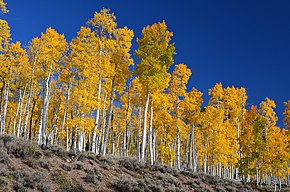
Back أقدم الأشجار في العالم Arabic Спіс найстарэйшых дрэў Byelorussian Списък на най-старите дървета в света Bulgarian فهرست کهنسالترین درختان Persian Liste des arbres les plus anciens French Lista celor mai longevivi arbori Romanian Список старейших деревьев Russian En yaşlı ağaçlar listesi Turkish Список найстаріших дерев Ukrainian

This is a list of the oldest-known trees, as reported in reliable sources. Definitions of what constitutes an individual tree vary. In addition, tree ages are derived from a variety of sources, including documented "tree-ring" (dendrochronological) count core samples, and from estimates. For these reasons, this article presents three lists of "oldest trees," each using varying criteria.
There are three tables of trees, which are listed by age and species. The first table includes trees for which a minimum age has been directly determined, either through counting or cross-referencing tree rings or through radiocarbon dating. Many of these trees may be even older than their listed ages, but the oldest wood in the tree has rotted away. For some old trees, so much of the center is missing that their age cannot be directly determined. Instead, estimates are made based on the tree's size and presumed growth rate. The second table includes trees with these estimated ages. The last table lists clonal colonies in which no individual tree trunks may be remarkably old but in which the organism as a whole is thought to be very old.
The current record-holders for individual, non-clonal trees are the Great Basin bristlecone pine trees from California and Nevada, in the United States. Through tree-ring cross-referencing, they have been shown to be almost five millennia old.[2]
A clonal colony can survive for much longer than an individual tree. A colony of 48,000 quaking aspen trees (nicknamed Pando), covering 106 acres (43 ha) in the Fishlake National Forest of Utah, is considered one of the oldest and largest organisms in the world. Recent estimates set the colony's age at several thousand (up to 14,000) years, although tree ring samples date individual stems at rarely more than 130 years.[3][4][5][6][7] A colony of Huon pine trees covering 2.5 acres (1.0 ha) on Mount Read (Tasmania) is estimated to be around 10,000 years old, as determined by DNA samples taken from pollen collected from the sediment of a nearby lake. Individual trees in this group date to no more than 4,000 years old, as determined by tree ring samples.[8]
- ^ https://www.biorxiv.org/content/10.1101/2024.10.19.619233v2.full.pdf
- ^ Farmer, Jared (2022). Elderflora: A Modern History of Ancient Trees. Basic Books. ISBN 978-0-465-09785-2.
- ^ Rogers, Paul C.; McAvoy, Darren J. (2018-10-17). "Mule deer impede Pando's recovery: Implications for aspen resilience from a single-genotype forest". PLOS ONE. 13 (10): e0203619. Bibcode:2018PLoSO..1303619R. doi:10.1371/journal.pone.0203619. ISSN 1932-6203. PMC 6192553. PMID 30332420.
- ^ Ding, Chen; Schreiber, Stefan G.; Roberts, David R.; Hamann, Andreas; Brouard, Jean S. (2017-07-05). "Post-glacial biogeography of trembling aspen inferred from habitat models and genetic variance in quantitative traits". Scientific Reports. 7 (1): 4672. Bibcode:2017NatSR...7.4672D. doi:10.1038/s41598-017-04871-7. ISSN 2045-2322. PMC 5498503. PMID 28680120.
- ^ Grant, Michael C. (1 October 1993). "The Trembling Giant". Discover Magazine. Archived from the original on 17 May 2012. Retrieved 8 May 2008.
- ^ "Botanical Record-Breakers". W.P Armstrong. Archived from the original on 19 December 2010. Retrieved 7 May 2008.
- ^ "SPECIES: Populus tremuloides". USDA - United States Forest Service. Archived from the original on 5 September 2012. Retrieved 8 May 2008.
- ^ "Native Conifers of Tasmania". Paks and Wildlife Service, Tasmania. Archived from the original on 28 July 2012. Retrieved 6 May 2008.